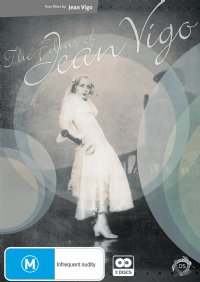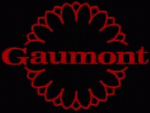The Films of Jean Vigo (Directors Suite) (1934) |
|
The Films of Jean Vigo (Directors Suite) (1934) |
|


|
| BUY IT |
| General | Extras | ||
| Category | Drama |
Audio Commentary-by Dr. Wendy Haslem, Lecturer in Film at the Uni. of Melb. Trailer-Four Directors Suite trailers Short Film-A propos de Nice Short Film-Taris, Roi de l'Eau Short Film-Zero de Conduite Featurette-Interview with Filmmaker Otar Iosseliani Featurette-SoundRegained: an insight into audio restoration |
|
| Rating |

|
||
| Year Of Production | 1934 | ||
| Running Time | 157:1 (Case: 165) | ||
| RSDL / Flipper |
RSDL (62:40) Dual Disc Set |
Cast & Crew | |
| Start Up | Ads Then Menu | ||
| Region Coding | 4 | Directed By | Jean Vigo |
|
Studio
Distributor |
 Madman Entertainment |
Starring |
Michel Simon Dita Parlo Jean Daste Gilles Margaritis Louis Lefebvre Maurice Gilles Raphael Diligent |
| Case | Amaray-Transparent-S/C-Dual | ||
| RPI | $34.95 | Music | Maurice Jaubert |
| Video | Audio | ||
| Pan & Scan/Full Frame | Full Frame |
French Dolby Digital 2.0 (224Kb/s) English Audio Commentary Dolby Digital 2.0 (224Kb/s) |
|
| Widescreen Aspect Ratio | None | ||
| 16x9 Enhancement | No | ||
| Video Format | 576i (PAL) | ||
| Original Aspect Ratio | 1.37:1 | Miscellaneous | |
| Jacket Pictures | No | ||
| Subtitles |
English English Alternate Subtitles |
Smoking | Yes |
| Annoying Product Placement | No | ||
| Action In or After Credits | No | ||
Jean Vigo made only four films prior to his death at the young age of 29 from tuberculosis. Two of these films where short films (Ŕ Propos de Nice and Taris, Roi de l'Eau) while his final two films were feature films (Zéro de Conduite and L'Atalante), although Zéro de Conduite was only 42 minutes in length, it is Vigo's final film, L'Atalante that he is remembered and revered for. L'Atalante is regarded as an integral part of film history as can be seen from the 2002 British Sight and Sound Critic's Poll which ranked it as the 15th best movie of all time.
The premise of the main plot is simple. Jean (Jean Dasté) is the captain of the canal barge L'Atalante. In the opening scenes we witness his marriage to Juliette (Dita Parlo). As they leave the church to spend their honeymoon on the barge, they decide to spend time in Paris after the boat has docked to deliver cargo from its trip from Le Havre (a distance of 180 km). Juliette, who finds life on board the L'Atalante difficult due to the claustrophobic conditions and attitudes of the crew, who are not used to having a female on-board, decides to stay in Paris after the barge leaves. She gets a taste for the city life, in comparison to her slow-paced country life background. What will Jean do in regards to this situation, especially as he barely knows Juliette?
The cinematographer on L'Atalante was Dziga Vertov's brother, Boris Kaufman who went on to be the main cinematographer of Elia Kazan's 1954 film, On The Waterfront and Sidney Lumet's 1957 film, 12 Angry Men. Kaufman won the Oscar for Best cinematography for On The Waterfront. The influence of quick editing to create action sequences from Russian filmmakers Sergei Eisenstein and Dziga Vertov can be seen in L'Atalante. Also, the plot of the F.W. Murnau's similarly highly regarded film, 1927's Sunrise, can be seen in Jean and Juliette's relationship. Sunrise is a more seriously-themed film, the main antagonist in the plot of L'Atalante, the first mate Jules, is deliberately comical, as played by Michel Simon. Michel Simon was the perfect choice for such a part, having played a similar larger-than-life character in Jean Renoir's 1932 film, Boudu Saved from Drowning (which was incidentally remade in 1986 as Down and Out in Beverly Hills starring Bette Midler, Richard Dreyfuss and Nick Nolte).
Another innovative technique used by Vigo and Kaufman was the underwater slow motion and fantasy sequences, something that was copied and used by other directors later on. At the time of his death in 1934, Jean Vigo's films were not critically regarded. This occurred later in the 1950s with the critical support of the French New Wave critics and Directors such as Francois Truffaut.
The two-disc package by Madman's Directors Suite label would have to be the most important Directors Suite release of 2009 and an essential purchase for Region 4 fans of classic cinema. L'Atalante is the main presentation on disc one, with an audio commentary by Dr. Wendy Haslem and the other three short films (Ŕ Propos de Nice, Taris, Roi de l'Eauare and Zéro de Conduite) presented on disc two, together with two other short featurettes.
Despite undergoing restoration in 1990 and 2001, the video quality is not frame-by-frame. These restorations mainly dealt with restoring the film to its current length and repairing the significant damage to the audio track. When L'Atalante was released in 1934, it was a commercial and critical failure. As a result, it was cut and renamed and re-released as a 65 minute feature. The film on disc one is the original length (although it is four minutes shorter due to PAL speed-up)
The aspect ratio of L'Atalante is 1:33:1 full frame.
L'Atalante has been presented here with a sharp video transfer for its age, as well as good shadow detail and minimal grain. The average bitrate of the film is 6.86 m/b per sec which is quite good for DVD.
The Black and White cinematography is of excellent quality for the period in which the film was shot in 1934.
The restoration work has not removed dust and scratches from the main print. Therefore there are still film artefacts such as black and white artefacts, lines and reel change markings visible, with telecine wobble also present at times.
Again, we viewers get the sublime choice of viewing the film with optional white or yellow subtitles. This is a highly commendable practice from Madman and one which I certainly greatly appreciate.
The RSDL change occurs during a scene change at 62:40.
| Sharpness | |
| Shadow Detail | |
| Colour | |
| Grain/Pixelization | |
| Film-To-Video Artefacts | |
| Film Artefacts | |
| Overall |
The special feature on disc two highlights just what a poor shape the original audio of L'Atalante was in, with loud background hiss and many audio pops, clicks and dropouts. The restoration has done a great job to present the main soundtrack so well.
Both the audio tracks for L'Atalante, the main soundtrack and the audio commentary have been encoded in Dolby Digital 2.0 at 224 kbps.
Dialogue is usually clear and synchronised, but not always. This would only be disconcerting if viewed in French. Besides, the original vocal delivery of Michel Simon's lines were supposed to be slightly ambiguous and muffled.
The main theme song by Maurice Jaubert is easily memorable and fits in well with the plot of the film been centred on a barge. Also, it has an otherworldly ethereal quality to it which also supports the film's plot points well.
There is no surround channel usage at all.
The subwoofer is not utilised either.
| Dialogue | |
| Audio Sync | |
| Clicks/Pops/Dropouts | |
| Surround Channel Use | |
| Subwoofer | |
| Overall |
NOTE: To view non-R4 releases, your equipment needs to be multi-zone compatible and usually also NTSC compatible.
The Complete Jean Vigo was released by Artificial Eye in 2004 with the same four main features. The Region 4 release by Directors Suite contains an audio commentary whereas the Region 2 set has more extra features such as a 94 minute documentary on Jean Vigo, a 38 minute feature on the cuts made to L'Atalante for its many releases over the years, a 10 minute introduction to 1990 restored version of L'Atalante, a newsreel on Jean Taris, a poster and stills gallery and a textual biography on Jean Vigo.
The Region 2 Artificial Eye release contains ore extras, but the Region 4 Directors Suite release is still a good choice for Australian fans of classic cinema.
This is without doubt the most important release by Directors Suite in 2009. This release of Jean Vigo's films represents an opportunity for Region 4 cinema fans of classic films to finally own and view Jean Vigo's highly praised works. It goes without saying that this comes highly recommended. Do yourself a favour and pick it up from your local DVD retailer today!
| Video | |
| Audio | |
| Extras | |
| Plot | |
| Overall |
| Review Equipment | |
| DVD | Sony BDP-S550 (Firmware updated Version 020), using HDMI output |
| Display | Samsung LA46A650 46 Inch LCD TV Series 6 FullHD 1080P 100Hz. Calibrated with THX Optimizer. This display device is 16x9 capable. |
| Audio Decoder | Sony STR-K1000P. Calibrated with THX Optimizer. |
| Amplification | Sony HTDDW1000 |
| Speakers | Sony 6.2 Surround (Left, Front, Right, Surround Left, Surround Back, Surround Right, 2 subwoofers) |